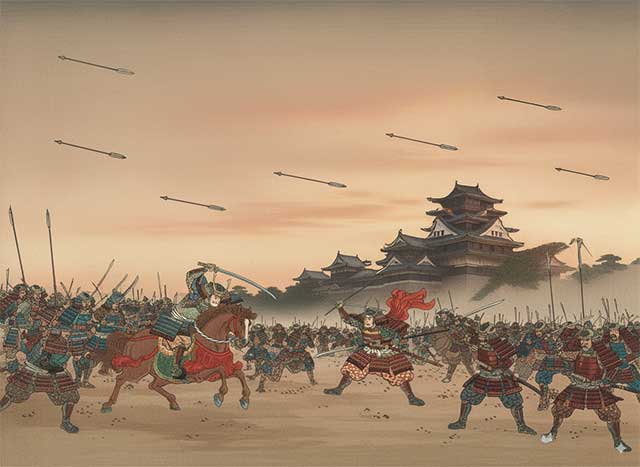
By 1517, Takeda Motoshige, lord of Kanyama Castle, was probably the most influential daimyo in Aki Province. Ten years earlier, he had served as a vassal of the Ōuchi clan and participated in Ōuchi Yoshiyuki's campaign in Kyoto. This campaign was part of an effort to support the deposed shogun Ashikaga Yoshitane.
However, relations between the Ōuchi and Takeda clans were difficult and not mutually beneficial. At the end of the 15th century, taking advantage of internal strife within the Takeda clan, the Ōuchi invaded their lands and forced them to swear allegiance. When Motoshige was able to return to Aki, he enlisted the support of the Amago clan and freed himself from the Ōuchi's imposed “guardianship.”
The death of Mori Okimoto
In 1516, Mori Okimoto, the daimyo of the neighboring Mori clan, died unexpectedly. His youngest son, Komatsumaru, became his heir. The situation of weakened power was too tempting for rivals, and Takeda Motoshige decided to take advantage of it. Knowing that the main forces of the Ouchi clan were still in Kyoto, he gathered an army of about 5,000 warriors and invaded the lands of the Kikkawa clan, an ally of the Mori. Takeda laid siege to Arita Castle, which was commanded by Oda Nobutada.
The Mori's challenge
A few weeks later, Motoshige launched a raid deep into the Mori clan's territory. He set fire to the village of Tajihi, hoping to force Mori into open battle.
Mori's army was led by Motonari, the younger brother of the late Okimoto and guardian of the young Komatsumaru. He was only twenty years old, and this was his first military campaign.
Motonaori's Preparations
Motonaori could not count on the help of Ouchi's troops, so he mobilized his own vassals. Awa, Fukuhara, Inoue, Kutiba, and Watanabe gathered under his banners. In total, he managed to gather about seven hundred warriors, who were joined by another three hundred fighters from the Kikaw clan.
These forces marched towards Arita Castle. On the way, they encountered the vanguard of Takeda's army, numbering five hundred men, commanded by Kumagai Motonao.
The death of Kumagai Motonao
The allied forces stopped and opened fire on the enemy with their bows. Motonao himself was in the front ranks, encouraging his warriors and inspiring them to fight. But this cost him his life — he was struck by an enemy arrow.
The battle at the Matauti River
At that time, Motoshige was with the main forces at Arita Castle. Upon learning of the defeat of the vanguard, he gathered his troops and led them to avenge their fallen comrade. Takeda's army attacked the forces of Mori and Kikkawa, who had taken up positions on the opposite bank of the Matauti River.
Takeda had a numerical advantage. The allied forces faltered and were ready to retreat. They were held back only by Motonari's constant exhortations and personal presence.
The death of Motoshige and Mori's victory
At that moment, Motoshige himself rushed into battle. He forced his way across the river on horseback, but was almost immediately struck by a well-aimed arrow and fell on the battlefield.
The death of their leader was a turning point. Takeda's troops fled, and Motonari was victorious.
Consequences
This victory paved the way for the rise of the Mori clan. From that moment on, their influence grew not only in the province of Aki, but throughout the Chugoku region.
See also
-
The Siege of Hara Castle

The Shimabara Rebellion of 1637–1638, which culminated in the siege of Hara Castle, was the last major uprising of the Edo period and had serious political consequences.
-
Battle of Tennoji

The confrontation between Tokugawa Ieyasu and Toyotomi Hideyori during the “Osaka Winter Campaign” ended with the signing of a peace treaty. On January 22, 1615, the day after the treaty was signed, Ieyasu pretended to disband his army. In reality, this meant that the Shimazu forces withdrew to the nearest port. On the same day, almost the entire Tokugawa army began filling in the outer moat.
-
Siege of Shuri Castle

The Ryukyu Kingdom was established in 1429 on Okinawa, the largest island of the Ryukyu (Nansei) archipelago, as a result of the military unification of three rival kingdoms. In the following years, the state's control spread to all the islands of the archipelago.
-
The Siege of Fushimi Castle
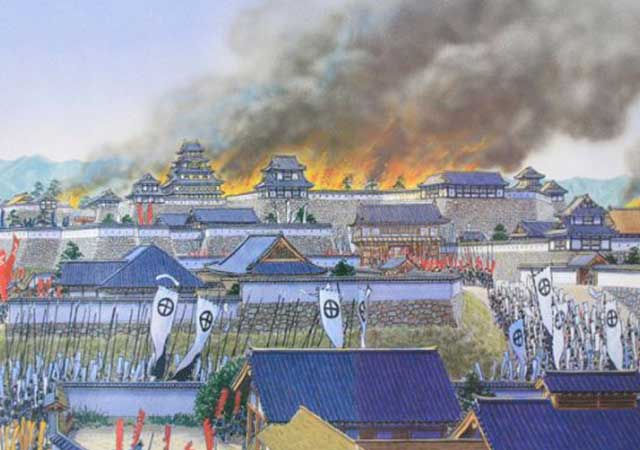
Fushimi can perhaps be considered one of the most “unfortunate” castles of the Sengoku Jidai period. The original castle was built by Toyotomi Hideyoshi in the southeast of Kyoto in 1594 as his residence in the imperial city.
-
The Siege of Otsu Castle
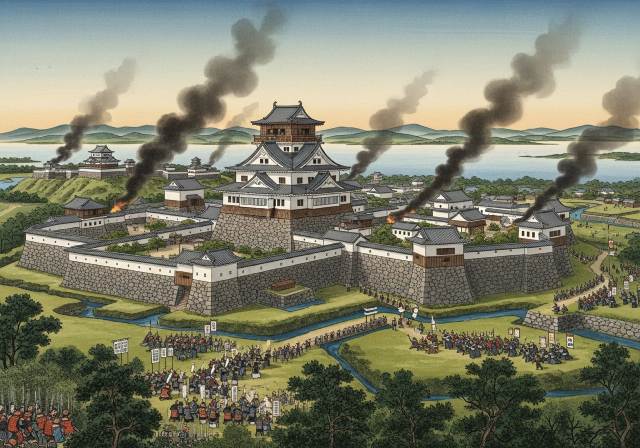
The siege of Otsu Castle was part of the Sekigahara campaign, during which the so-called Eastern Coalition, led by Tokugawa Ieyasu, fought against the Western Coalition, led by Ishida Mitsunari. Otsu Castle was built in 1586 by order of Toyotomi Hideyoshi near the capital Kyoto, on the site of the dismantled Sakamoto Castle. It belonged to the type of “water castles” — mizujō — as one side of it faced Japan's largest lake, Lake Biwa, and it was surrounded by a system of moats filled with lake water, which made the fortress resemble an island.
-
The Siege of Shiroishi Castle
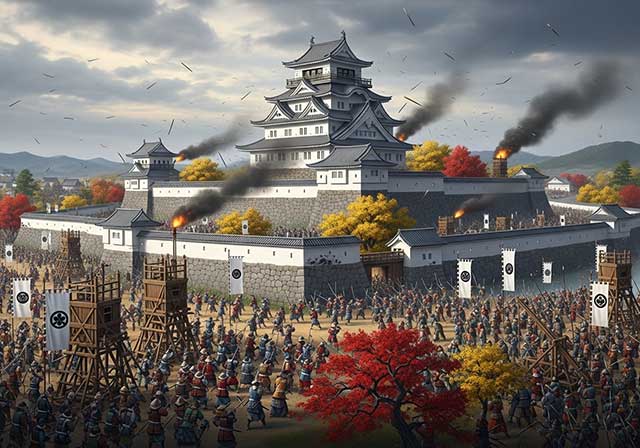
The siege of Shiroishi Castle was part of the Sekigahara campaign and took place several months before the decisive battle of Sekigahara. The daimyo of Aizu Province, Uesugi Kagekatsu, posed a serious threat to Tokugawa Ieyasu's plans to defeat the Western Coalition, and Ieyasu decided to curb his actions with the help of his northern vassals. To this end, he ordered Date Masamune to invade the province of Aizu and capture Shiroishi Castle.
-
The Second Siege of Jinju Castle
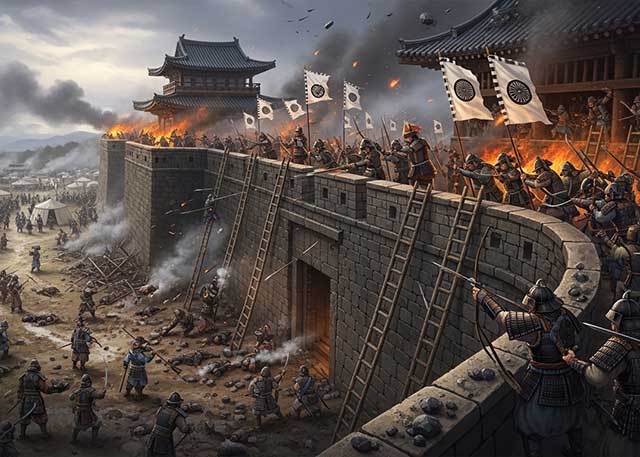
During the two Korean campaigns of the 16th century, the Japanese repeatedly had to capture enemy fortresses and defend occupied or constructed fortifications from the combined Korean and Chinese forces. Among all the operations of that time, the second siege of Jinju Castle is considered the most interesting from the point of view of siege warfare.
-
The Siege of Takamatsu Castle
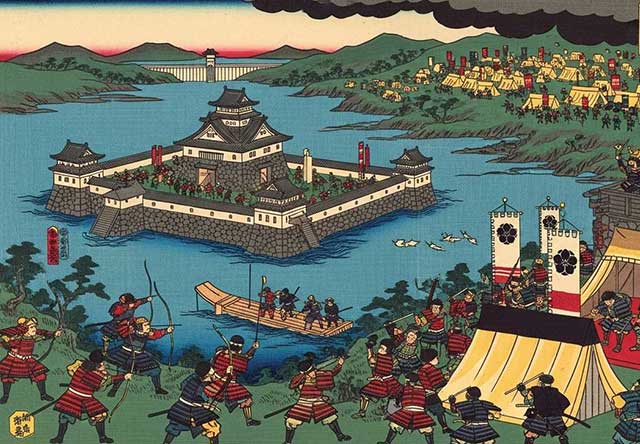
The siege of Takamatsu Castle in Bitchu Province is considered the first mizuzeme, or “water siege,” in Japanese history. Until then, such an original tactic had never been used.

